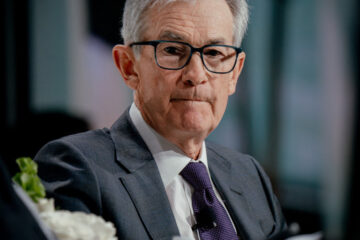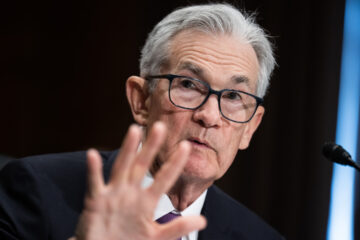A key Treasury auction this week could test one of the central planks of President Donald Trump’s tariff strategy as markets reel amid the largest swings in Treasury yields in more than two decades.
President Trump has insisted that his tariff plans, which will impose sweeping levies on goods imported from virtually every nation in the world, paid for by American companies and consumers, will ultimately benefit the domestic economy with lower interest rates even they slow growth and stoke inflation along the way.
The Federal Reserve, meanwhile, wants to see more evidence of their impact on the world’s biggest economy over the coming months before committing to a change in interest rates, which currently sit between 4.25% and 4.5%.
So far, Trump is finding some success in lowering market interest rates, which most investors view through the 10-year Treasury bond yield, although economists see that movement as a reflection of recession risk rather the tariff success.
Benchmark 10-year note yields started the year at around 4.577%, according to Tradeweb data, and fell below the 4% mark last week for the first time since Trump’s election in November.
Treasury Secretary Scott Bessent has said the Trump administration in focused on lowering 10-year Treasury bond yields. They’ll need foreign investors to do it.
Movements this week, however, have been chaotic, with the paper reaching a multi-year low of 3.87% in overnight trading on Monday, before rising to 4.21% during the heaving volatility that dominated markets on Tuesday.
Bond markets in chaos
Those intra-day moves, in fact, were the largest in twenty-five years, according to Tradeweb data, and likely represent a host of markets risks heading into the April 9 start date the President has set for his ‘Liberation Day’ tariffs.
That date, however, also corresponds with the sale of around $39 billion in 10-year notes, the middle of three coupon auctions that will raise around $119 billion for the Treasury this week.
The overlap is key because foreign buyers play a crucial role in these auctions buy holding down borrowing rates and assisting in the financing of the current government deficit, which topped $1.147 trillion in February and could rise to as high as $2 trillion by the end of the financial year in September.
Related: Crushing the dollar won’t solve America’s debt problem. It’ll make it worse
Last month, indirect bidders, which are comprised mostly of foreign central banks, took down around 67.4% of the $39 billion 10-year auction, and scooped up around 71.5% of a $42 billion sale in February.
There are a host of reasons why foreign buyers are attracted to U.S. Treasury bonds, including the dollar’s status as the world’s reserve currency, the iron-clad safety of the bonds themselves and the role that U.S. interest rates play in calculating the value of financial assets.
But another determining factor is the role that global trade plays in the demand for U.S. Treasuries, and by extension how that helps keep borrowing costs low and allows the government to continue running budget deficits, while piling on new debt, each and every year.
Trade deficits keep rates low
Overseas companies selling goods into the U.S. are paid in U.S. dollars. They typically swap those dollars (first with their own bank, which then does the same with the central bank).
A good portion of those dollars find their way back into the U.S. in the form of investments, either in plants, manufacturing, research or marketing. But they also flow into Treasury bond auctions.
In fact, the biggest holders of U.S. Treasuries – China and Japan – have run the largest trade surpluses over the past two decades.
Related: There’s no need for a trade war; America’s already won it. By a lot.
Now, however, with the Trump administration planning levies north of 50% on China, and threatening even steeper duties over the coming days, with tariffs set to kick-in on Europe, Canada and a host of trading partners on Wednesday, can those flows into the Treasury market continue?
If they can, Treasury bond prices are likely to increase, and Treasury bond yields (a loose proxy for government borrowing costs) are likely to decline (as they move in opposite directions).
If foreign buying of U.S. debt recedes, however, as a result of slowing trade flows, or a ‘buyer’s strike’ from foreign central banks, the administration’s goal of lowering market rates will find and immense challenge.
Debt ceiling risks loom
And that challenge will come at the worst possible time, as not only is U.S. debt rising past $36 trillion, and on course to top $50 trillion over the next few years, but the current debt ceiling standoff could trigger payment and default risks as early as this summer if a deal isn’t reached between Republican lawmakers over the coming months.
Foreign buyers, meanwhile, might not be as keen to finance the $5.4 trillion in tax cuts the Trump administration is seeking if, at the same time, they’re having access to U.S. markets limited by tariffs and threatened with new and unpredictable levies if they dare to impose reprisal duties.
Related: Don’t expect the Fed to rescue stocks from tariff gambit
America’s trade deficit, however its viewed politically, has allowed Congressional lawmakers to avoid difficult tax and spending decisions.
Turning off the tap of foreign bond buyers, while planning to borrowing trillions more on an economic gamble, might be a bigger risk to U.S. growth than the tariffs themselves.
More Economic Analysis:
Wall Street overhauls S&P 500 price targets as tariff selloff acceleratesInflation would like a word, pleaseStocks could bounce, but big bank earnings hold the cards


